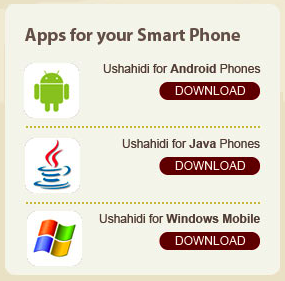All of the Ushahidi mobile apps run utilizing the Ushahidi API. They work as a mobile client, where you can access a specific web-based instance of Ushahidi (ex: http://hatari.co.ke or http://drc.ushahidi.com). The basic functionality allowed is for you to see new reports that others have reported, upload incidents with pictures/links/location and it allows you to run and report things offline for sync later when you are able to connect.
Android
 Josiah Mugambi is starting us off with an overview of the Ushahidi Android application. His phone is synced with the Hatari instance, which maps crime and corruption in Nairobi. The Android app seems to have a number of bugs, including the instance map is not syncing with the Android app's map. You can help us fix these bugs, or create your own using the source code found here.
iPhone
Wilfred Mworia is here to show some of the development on the Ushahidi iPhone app. Of all the mobile apps, this is the only one that isn't in production and ready to use. The source code is available on Github, for anyone who would like to help complete it.
J2ME (Java)
Jessica Colaco is showing the J2ME application for Ushahidi. It's a very basic setup that works on all Java-enabled phones. This app gives us the greatest reach, especially beyond people with specific smartphone applications. The code is here.
Windows Mobile
Unfortunately Dale Zak wasn't present to give us a demo of the WinMo app. It's the one that has had the most feedback and iterations to its development, and is the most stable of the whole group. You can grab the code and extend it here.
Josiah Mugambi is starting us off with an overview of the Ushahidi Android application. His phone is synced with the Hatari instance, which maps crime and corruption in Nairobi. The Android app seems to have a number of bugs, including the instance map is not syncing with the Android app's map. You can help us fix these bugs, or create your own using the source code found here.
iPhone
Wilfred Mworia is here to show some of the development on the Ushahidi iPhone app. Of all the mobile apps, this is the only one that isn't in production and ready to use. The source code is available on Github, for anyone who would like to help complete it.
J2ME (Java)
Jessica Colaco is showing the J2ME application for Ushahidi. It's a very basic setup that works on all Java-enabled phones. This app gives us the greatest reach, especially beyond people with specific smartphone applications. The code is here.
Windows Mobile
Unfortunately Dale Zak wasn't present to give us a demo of the WinMo app. It's the one that has had the most feedback and iterations to its development, and is the most stable of the whole group. You can grab the code and extend it here.
 Josiah Mugambi is starting us off with an overview of the Ushahidi Android application. His phone is synced with the Hatari instance, which maps crime and corruption in Nairobi. The Android app seems to have a number of bugs, including the instance map is not syncing with the Android app's map. You can help us fix these bugs, or create your own using the source code found here.
iPhone
Wilfred Mworia is here to show some of the development on the Ushahidi iPhone app. Of all the mobile apps, this is the only one that isn't in production and ready to use. The source code is available on Github, for anyone who would like to help complete it.
J2ME (Java)
Jessica Colaco is showing the J2ME application for Ushahidi. It's a very basic setup that works on all Java-enabled phones. This app gives us the greatest reach, especially beyond people with specific smartphone applications. The code is here.
Windows Mobile
Unfortunately Dale Zak wasn't present to give us a demo of the WinMo app. It's the one that has had the most feedback and iterations to its development, and is the most stable of the whole group. You can grab the code and extend it here.
Josiah Mugambi is starting us off with an overview of the Ushahidi Android application. His phone is synced with the Hatari instance, which maps crime and corruption in Nairobi. The Android app seems to have a number of bugs, including the instance map is not syncing with the Android app's map. You can help us fix these bugs, or create your own using the source code found here.
iPhone
Wilfred Mworia is here to show some of the development on the Ushahidi iPhone app. Of all the mobile apps, this is the only one that isn't in production and ready to use. The source code is available on Github, for anyone who would like to help complete it.
J2ME (Java)
Jessica Colaco is showing the J2ME application for Ushahidi. It's a very basic setup that works on all Java-enabled phones. This app gives us the greatest reach, especially beyond people with specific smartphone applications. The code is here.
Windows Mobile
Unfortunately Dale Zak wasn't present to give us a demo of the WinMo app. It's the one that has had the most feedback and iterations to its development, and is the most stable of the whole group. You can grab the code and extend it here.
Ideas
- A way to manage the administrative functions of Ushahidi from your mobile phone.
- Connect the mobile apps into social networks.
- Ability to pull up just specific people's reports.